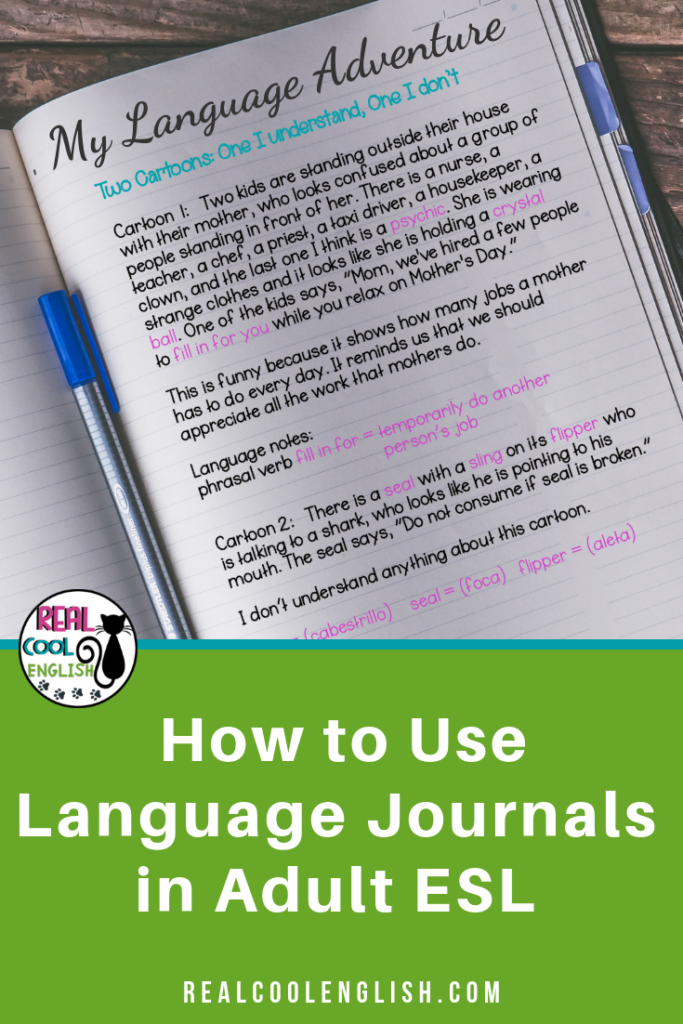For the past 15 years, I have taught many advanced level ESL classes, and most of the students I work with now tend to be more on the advanced side. Something that I commonly hear from my students is that after a certain point, they feel that they are having trouble progressing in English. This makes sense because when they are first learning, everything is new, and they can feel the progress almost daily. But once they are able to get by pretty well in most situations, they have already gone beyond what is available in most ESL resources. It becomes more and more difficult to find resources that are engaging as well as challenging, so they start feeling stuck. Sound familiar?
I’d assigned the students in my upper-level ESL class a short blog post to read so we could discuss it. I asked them to make notes about any words or phrases that were new to them.
The next day, when I asked if anyone had questions about the reading, they all confidently replied that everything was clear.
Not a single question.
How could that be? The post was rich with conversational expressions and phrasal verbs that I was sure most students would not be familiar with.
Why most advanced English learners stop making progress
This particular class was the highest ESL course that our college offered, and I often struggled with finding activities to help them take their English to the next level. We were not provided with specific course materials, and finding advanced ESL materials for adult students can be a real challenge.
I love using blog posts because they contain authentic language and are conversational in tone and vocabulary, which is difficult to find with prepared ESL materials.
I mean, seriously, why does every book for English language learners have things like, “When I arrived home…”
In real life casual speech (in the United States at least), who talks about arriving anywhere?
No one! Of course, we would say we got home.
But they learned the verb “arrive” in their level 1 English class, and “arrived [at/to] home” has stuck with them ever since, and they have probably never even noticed that no one actually says that.
So looking around at the confident faces of my students who had absolutely no questions about the reading, I asked if anyone knew what one of those phrases from the reading meant: “put up with.”
And suddenly, I was faced with a classroom of blank looks. Nobody raised their hand. Some looked back at the reading with quizzical expressions, genuinely surprised to now discover that phrase in there.
The power of noticing language
I got to thinking about this again the other day when one of my awesome students, Elizabeth, was telling me about a TED Talk she had seen, A Lesson on Looking by Amy Berman. In this Talk, the speaker discusses ways to improve our visual intelligence and have a deeper understanding of the things in our daily lives by asking questions about what we see. She compared it to looking at a piece of art and going beyond just what we can see on the surface. If we step back and ask questions about it, we can glean so much information beyond what we initially noticed.
I think that learning a language is much the same way.
If we approach it inquisitively, e.g. asking questions and looking at patterns, we can understand and remember it better. However, like any skill, the ability to observe language in a deep way is something that needs to be developed.
One of the most common frustrations I hear from my advanced students is that it is hard to continue to feel like they are making progress with their English. These students can read a blog post that is full of unfamiliar language, but because they are able get the main idea of the writing, they stop there. When they do, they miss an amazing opportunity to take their English skills to the next level.
The real reason students are not progressing with their English skills
I firmly believe that if students truly want to overcome this learning plateau, they must take more control of their learning. Every student’s level of English knowledge is unique, and they are the best judges of what they know, and what they don’t know. Only they know the types of situations that give them trouble, or when they feel at a loss for expressing themselves or understanding others.
Traditional ways of practicing English such as studying from ESL texts, using English learning websites, or even reading or listening to news articles often overlook the everyday language that students truly want to learn, and don’t help them overcome the English learning plateau!
Take a break from studying English to start noticing it
The good news is that natural, authentic English is all around them! This is even more true for those who live in a majority native English-speaking country.
Daily life gives us abundant opportunities to interact with the language, but the problem I saw with my students is that they were used to approaching what they read and hear in the same way that they did at the beginning of their journey: they judge how well they understand the material. At this stage, they may read something and think, “Oh yeah, I understand everything.”
This is what my students did with the blog post, but they didn’t spend time really looking at the language. They didn’t notice the things that were unclear. They just got the overall main idea.
To be clear, that skill is useful for many situations because we can’t just stop and analyze everything we read. But if they want to take their language skills to the next level so that they can begin to use the language they passively understand, they need to start noticing it and asking questions about it.
Our break-through moment
Later that day in class, we spent a few minutes talking about the phrasal verb “put up with” and brainstormed how we might use it in different situations. For example, things we have to put up with if we want to live in a big city: traffic jams, noisy streets, and spending half our paychecks on a cramped, outdated apartment.
Then in small groups, they worked to write sentences using that phrasal verb, and they shared their ideas with the class. This took about 20 minutes, but it got them thinking and discussing and they were interested in how to use it in a sentence.
And you know what else? I’m sure that after doing this activity, they noticed that phrasal verb the next time they saw or heard it. And noticing language is the first step to being able to use it.
Regularly doing this kind of activity with intentional, focused analysis can help take their mastery of English to the next level.
How to encourage the habit of noticing language
I have found that a language journal can be a great tool to help students analyze and organize the information they encounter. For this to work well, they need to be ready to take charge of their learning and be consistent with making entries every day.
It doesn’t have to be a long entry, and they don’t need to spend a lot of time on it. But getting into this daily habit of intentional learning and reflecting will keep them focused on their goal and allow them to see their progress over time.
While their classroom learning is at least to some extent directed by the teacher and/or curriculum, this journal is personal. Students include only those things that are useful or interesting to them.
Want to get your students started on a language journal? Here are a few ideas to get them started. For more ideas and specific suggestions for how to implement them, keep reading!
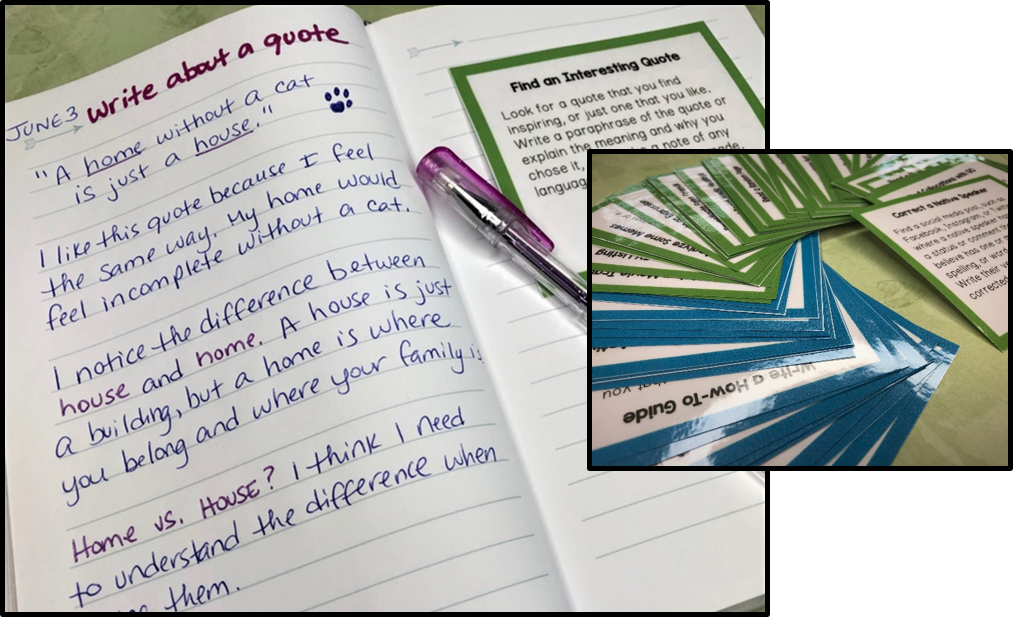
For a long time, I have encouraged students to keep a language journal so that they can record various examples of English: either something they heard or read and didn’t understand; a situation where they felt at a loss for how to respond; a word or phrase that they find interesting and want to start using themselves, etc. However, I found that students just didn’t understand how to even approach such a task.
That is why I decided to create a set of task cards with focused but flexible tasks to investigate and analyze the language closely.
Take a look at an example of one of the cards!
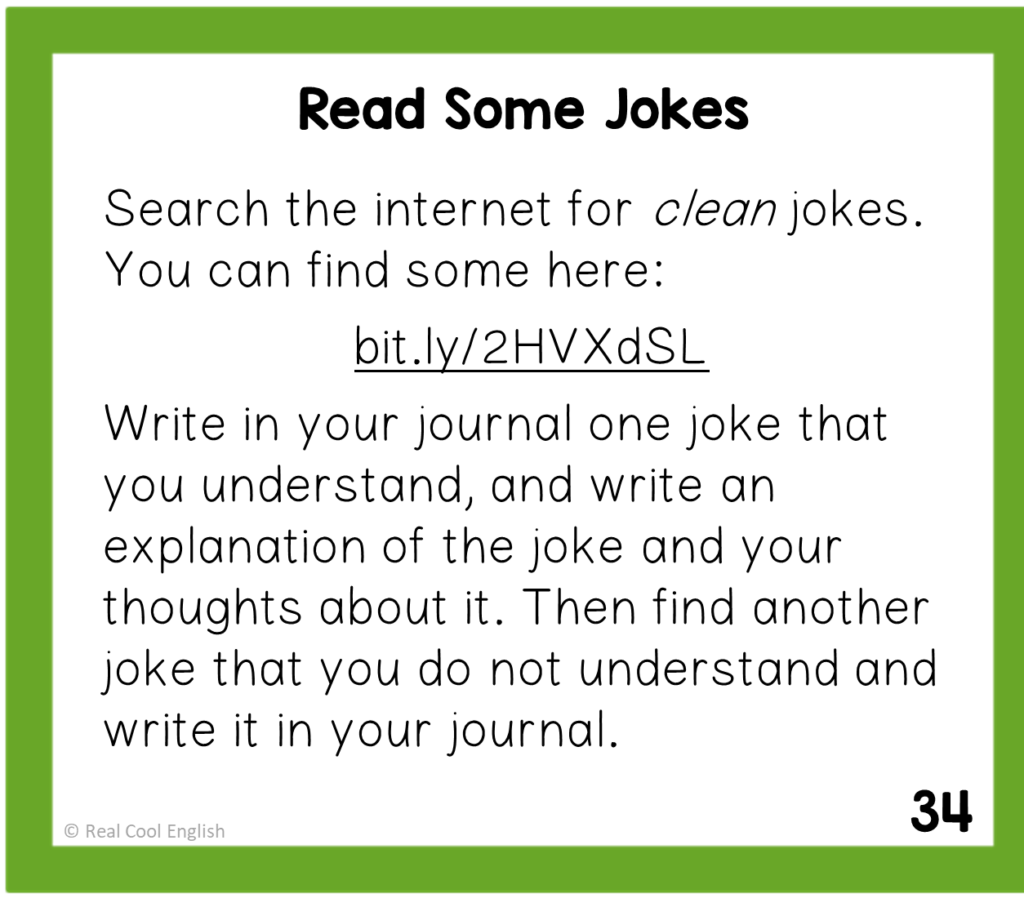
So for this assignment, students are given a focused challenge, but the great thing is that they are choosing the specific material to analyze and write about. Again, they are the best judges as to what they know and what they don’t know.
For each challenge, they will spend some time searching the Internet for two examples that fit the criteria. For the one they understand, they will need to explain it, and in doing so, they will likely find that they need to reach for vocabulary that they either don’t know or don’t use often. They also take note of any interesting words or phrases.
For the joke they don’t understand, they simply write it down, and work through their thought process: what they understand about the joke, what they don’t understand, or anything else that comes to their minds.
Here is an example of what a journal entry for this task might look like:
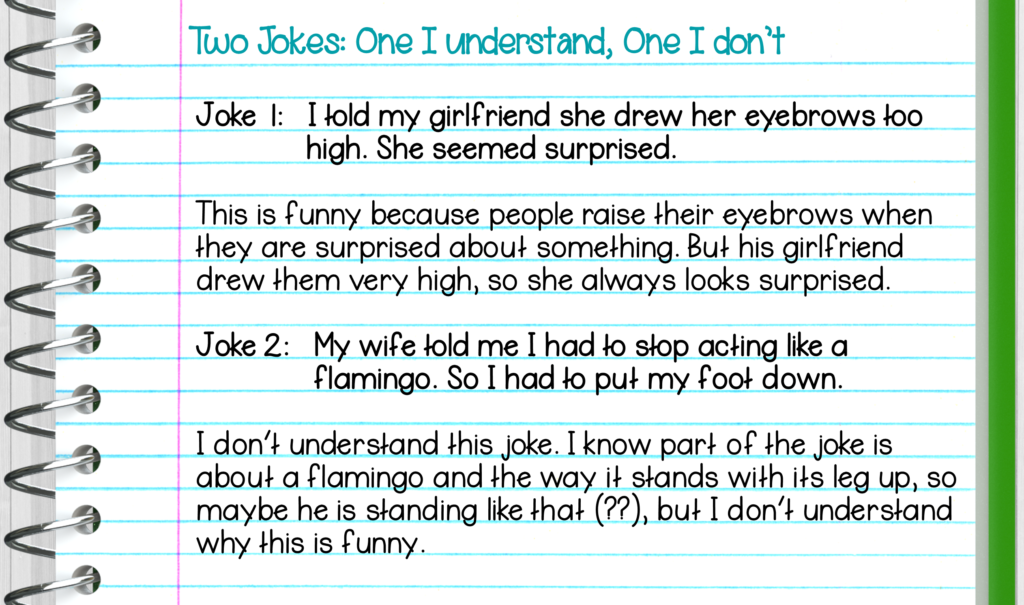
For the second joke, native speakers will understand immediately the play on words with the phrase “put my foot down.” In a normal situation, a student might come across such a joke, and just dismiss it because they don’t get it. This activity has them focusing on something that they don’t understand, allowing them the opportunity to discover this double meaning of “put my foot down.”
How does this help students build their language skills?
Ok, so they have completed this journal task, and they have discovered that they don’t understand something, now what? Well, actually this is the best part! And it works incredibly well in either in a classroom setting or a one-on-one teaching situation.

In a classroom, divide the class into small groups (say 3 or 4) and have them share both the joke they do understand (giving them a chance to explain it to anyone else in the group who does not get it) and the joke that they don’t understand (giving another student in the group who might understand it the opportunity to explain it.) I guarantee that they will have so much fun telling and talking about the jokes! And they will learn a lot in the process. After they have had their discussions, stop by each group and have them tell you any jokes that they were not able to figure out as a group. You can then explain them to the group.
In a one-on-one situation, you would simply discuss with your student at the next meeting the activity that they did, and you can read their journal entry, discuss the topic, and anything that they discovered or still need to know about it.
Another great thing about this activity is that after they have spent time focusing on bits of language that they have discovered or that they want to remember to use, they will almost surely start noticing that word or phrase used over and over in daily life, thus reinforcing their understanding of it, which is essential before they can expect to start being able to use it for themselves.
Here’s another example from one of the task cards:
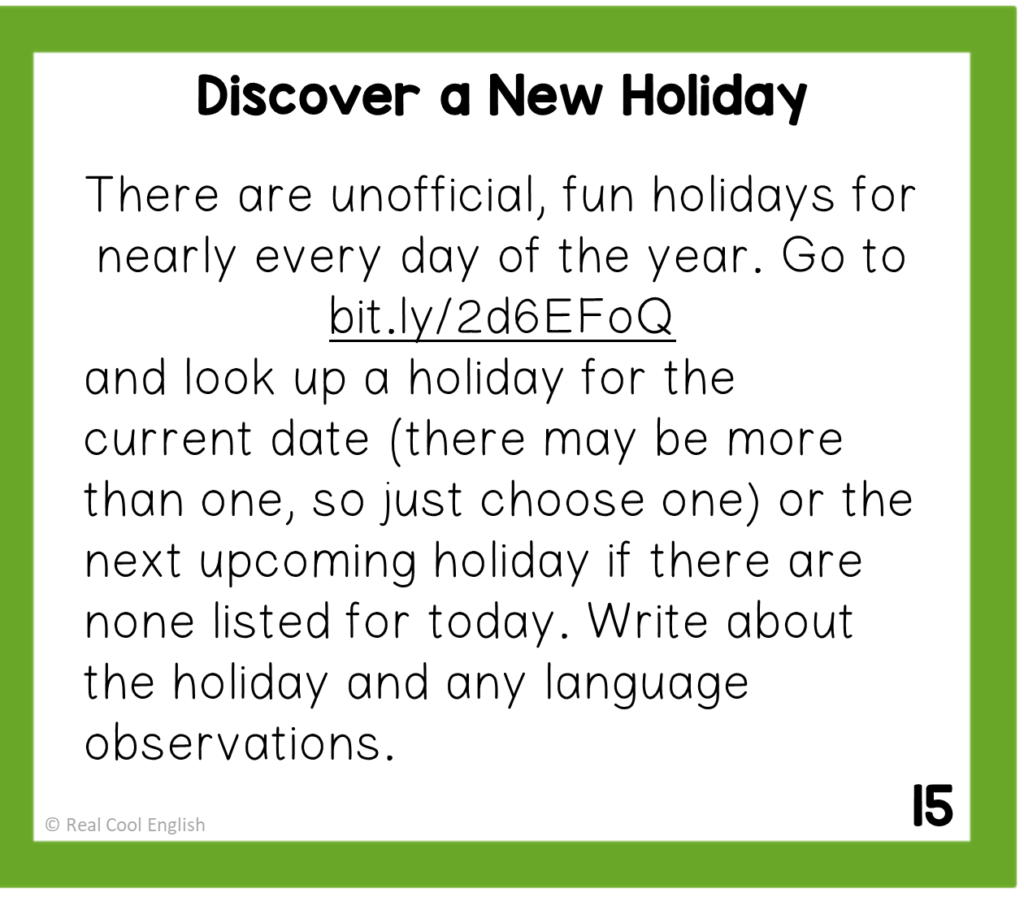
Take a look at an example of what a journal entry might look like for this activity:
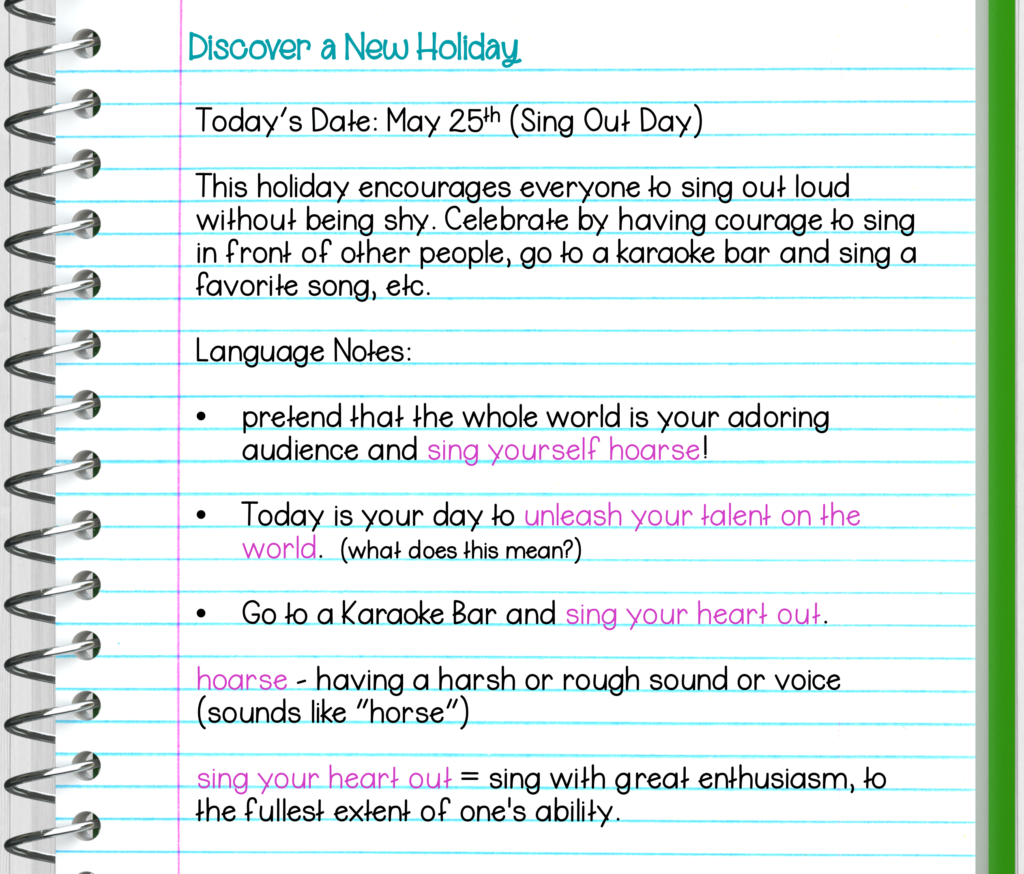
The fun holidays site gives short descriptions of the holiday and examples of how to celebrate it. Because each entry contains only a small amount of text, but the language is authentic and in a conversational style, it is a perfect example of language to analyze. Students reading about the holiday passively will probably understand the idea very well, but when they look at it closely, they will discover vocabulary or phrases that they might not otherwise notice.
Because students are writing about a holiday for the current date, it is an activity they can do over and over!
Want to follow up this activity with a class discussion? Instead of asking students to look up the current date, have them look up their birthday instead and share what they discovered in small groups.
How to get started with a language journal?
I would suggest at least for the first few journal activities to assign them a specific task. This will likely take some practice to be able to take full advantage of the learning opportunity that the tasks offer. After a while, they will hopefully get the feel of how it works, and then you could later decide to have them choose the activities they want to do.
Another great thing about the tasks is that for the vast majority of them, they are not limited to just one journal entry. With the above example of the jokes, after completing other tasks on the cards, students can always come back to this card and search for two more jokes, so the opportunities are endless!

In these cards, students will choose from a wide variety of activities, which use English examples from various sources. But the important thing is that much of what they are doing is examining authentic English rather than artificial examples created specifically for ESL learners.
So ultimately, the idea is to get them into the habit of changing the way they approach the language that they encounter: going from passively interacting with English to actively engaging with it, and find learning opportunities wherever they present themselves.
If you want to try a language journal with your students, I highly recommend giving them very focused tasks because this is not something that will come naturally to them. One great way find authentic, conversational English is by analyzing blog posts. I find that even the shortest ones are rich with the kind of language that native speakers actually use.
Who can benefit from keeping a language journal?
Although my focus here has been for advanced students, a language journal can be helpful for any student who already has a solid base in English and feels they need to overcome their English learning plateau. In fact, the earlier they start with this kind of activity, the better and faster they will learn.
Of course, you may have plenty of other ideas of English examples for them to investigate and analyze, but if you want something ready to go, try out this set of 60 task cards with a wide variety of activities.
Additionally, I have included journal examples for 19 of the activities for you to present to the students before assigning the task so that they will get a clear idea of what they need to look for and how to approach the task.
Finally, I have also included a list of websites that you and your students will find helpful for these activities and for English learning in general.
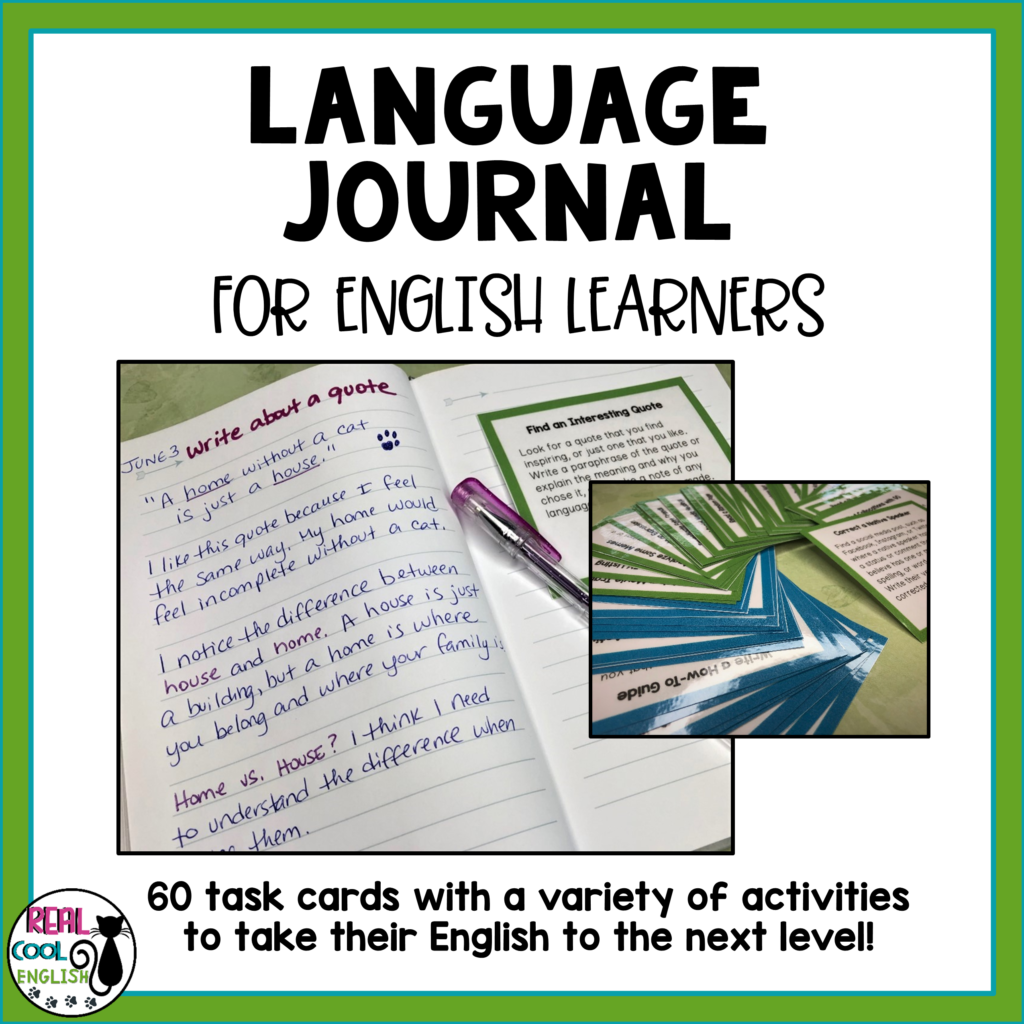
My students have had so much fun with the language journal activities, and they have become much more inquisitive about language, which has noticeably increased their productive learning. I’m sure your students will find that keeping a language journal is helpful for them as well!
Ready to try out these language journal tasks with your students and see them take charge of their learning so they can overcome the English learning plateau? Click the image above to get your set!
Need more activities for your upper-level students?
For more ideas for your upper-intermediate and advanced students, read about how you can use TED Talks with your students, and grab a FREE complete, no-prep lesson for your upper-intermediate or advanced ESL students! Also, subscribe to find out about new resources, sales, and promotions!
